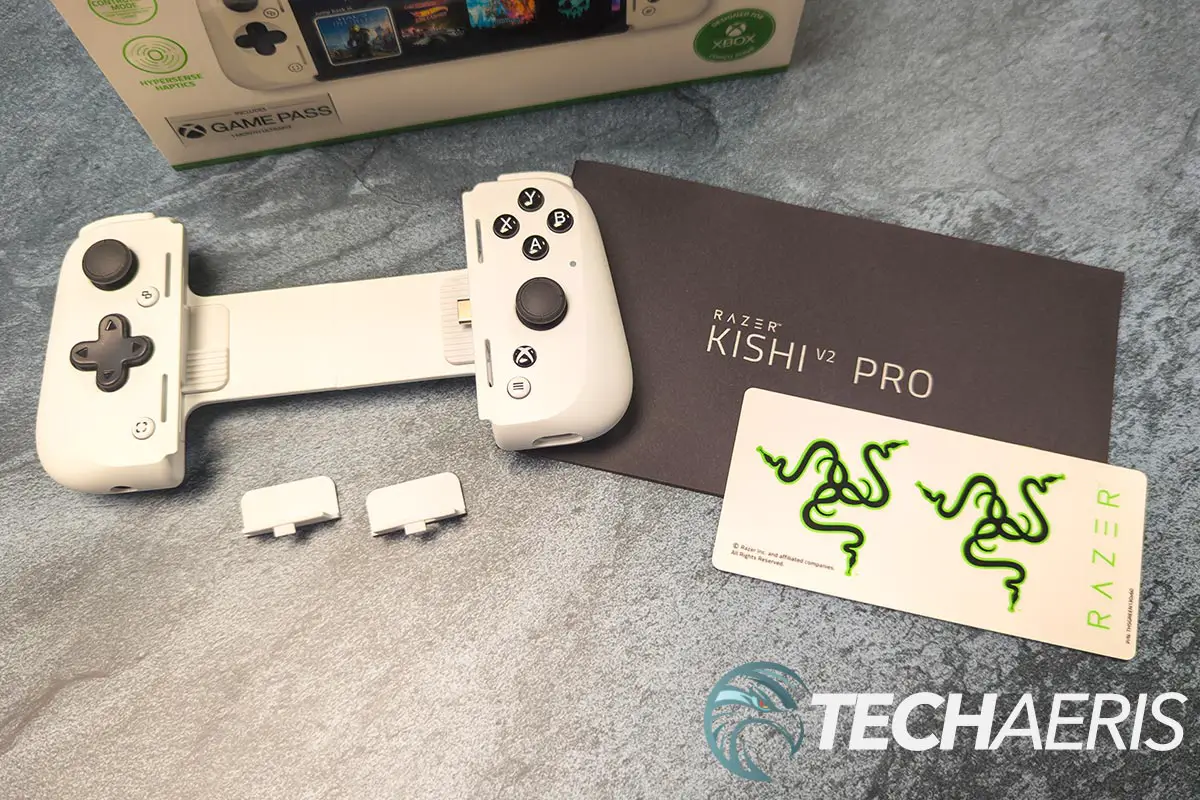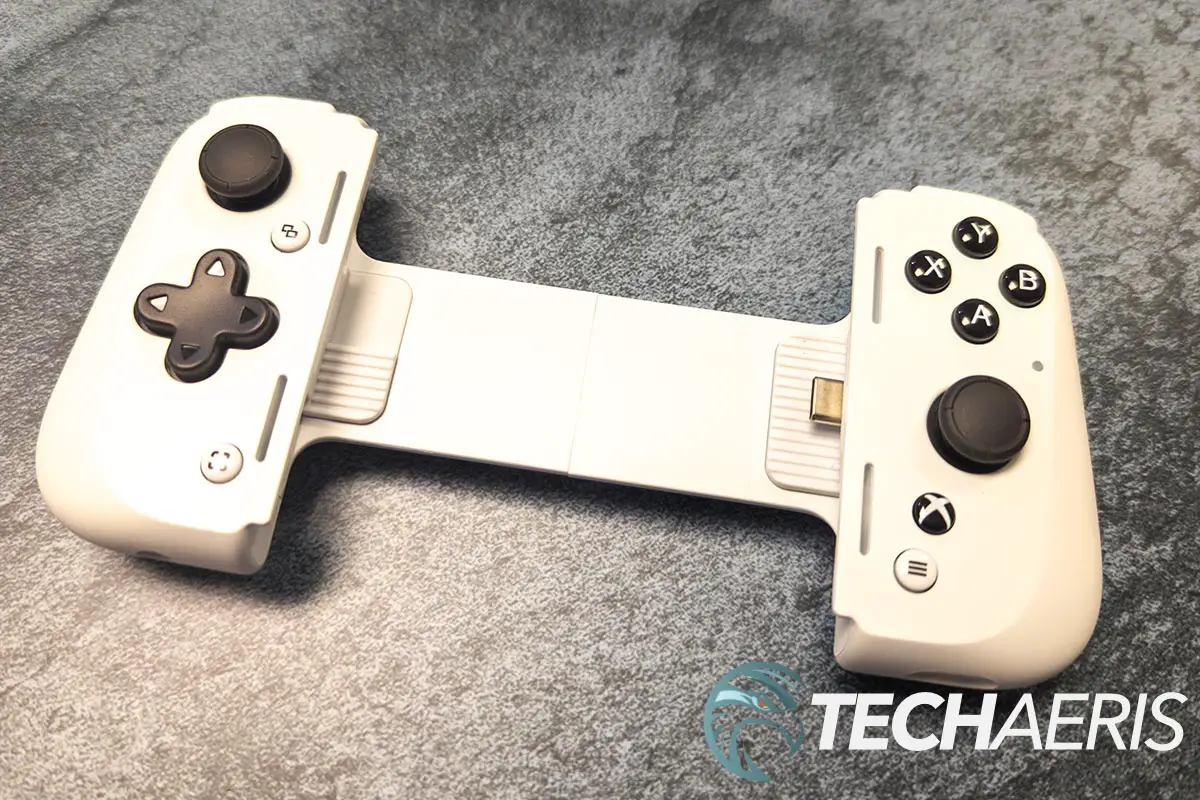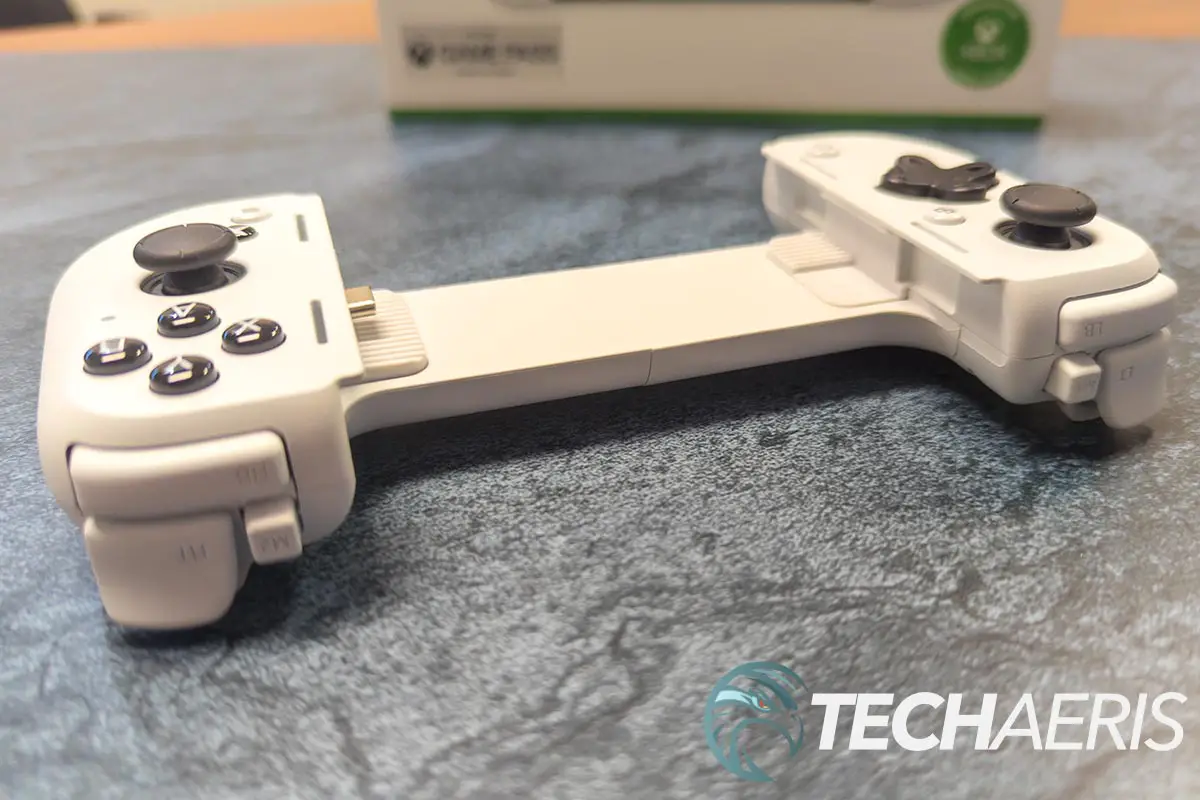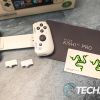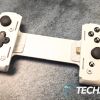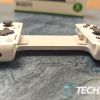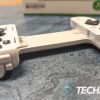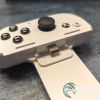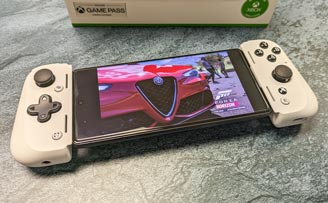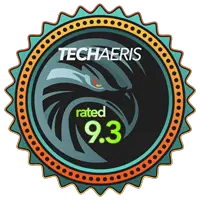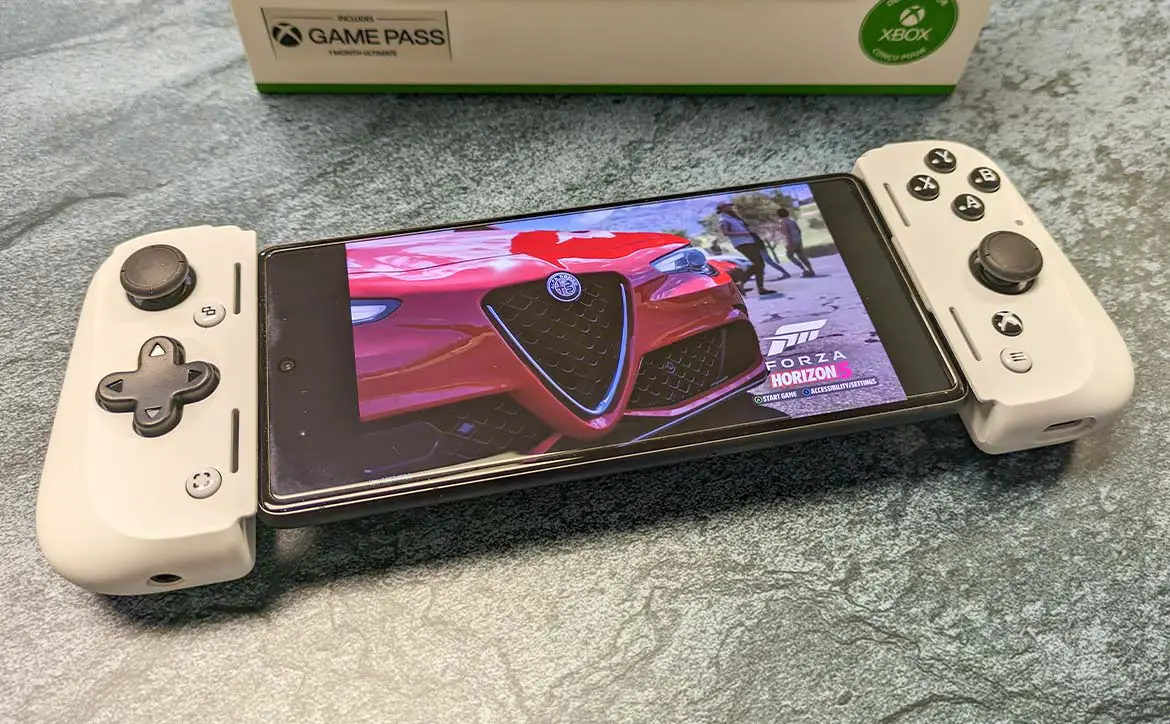
Several companies make mobile game controllers for Android and iPhone, and (in our opinion here at Techaeris) Razer makes one of the best. While the Razer Kishi was a first great kick at the can, the Razer Kishi V2 solidified the controller as a must-buy for mobile gamers wanting controller functionality while on their mobile devices.
Estimated reading time: 11 minutes
Our Razer Kishi V2 Pro review looks at the standalone version of the controller included with the Razer Edge, which brings haptic feedback and an audio jack to the device. Read on for our full review and see why it remains an Editor’s Choice here at Techaeris.
Table of contents
The Quick Take
Razer has steadily been improving its Razer Kishi mobile game controller. With the latest version, the Kishi V2 Pro, the last bit of the puzzle when it comes to an immersive gaming experience — haptic feedback — has been added to the mix. While it does take a few hoops to enable currently, and it is Android only at the moment, the Kishi V2 Pro is a minor, but a welcome upgrade over its non-pro predecessor.
Specifications
The Razer Kishi V2 Pro we reviewed has the following features and specifications:
- Connectivity: USB Type C
- Charging: Pass through charging
- Battery Life: None
- Clickable Thumbstick: Yes
- Thumbstick Sensitivity Adjustment: None
- Multi-function Buttons: 2
- Trigger Stops: None
- System Requirements: Android 10 or higher (HyperSense haptics compatibility varies depending on the game and requires Android 12 or higher)
- Mobile App: Yes, Razer Nexus 3.0
- Supported Phone Dimensions: Compatible with Samsung Galaxy S8 / S8+ / S9 / S9+ / S10 / S10+ / S20 Series / S21 Series / S22 Series / Note 8 / Note 9 / Note 10 / Note 10+ / Note 20, Google Pixel 2 / 3 / 4 / 5 / 6 / 7, and many other Android devices.
- Approximate Size: 92.2 mm x 180.7 mm x 33.9 mm (3.63 x 7.11 x 1.33″)
- Approximate Weight: 138 g (4.87 oz)
What’s in the box
- Razer Kishi V2 Pro mobile game controller
- 2 pairs of interchangeable rubber cushions
- Product Information Guide
- Razer Stickers
Design
As the Razer Kishi V2 Pro mobile game controller for Android only features minor upgrades, one under the hood, this review will be identical to the non-pro version for the most part. That out of the way…
The Razer Kishi V2 Pro has a stable sliding bridge design with an Xbox controller layout. On the left controller is a clickable analog thumbstick with a convex pad, the microswitch D-Pad, an options button between the two, and a dedicated share/streaming button near the bottom. On the right side are your microswitch ABXY buttons near the top, a second analog clickable thumbstick with a convex pad, an Xbox button (or Razer Nexus if not the white Xbox version of the controller) and a menu button below that.
On the bottom edge of the left controller is one of two visible additions: the 3.5mm audio jack. On the bottom edge of the right controller is a USB-C pass-through charging port, so you can charge your phone while gaming. The top edge of both controllers is where you’ll find your L2/R2 triggers, L1/R1 bumpers, and programmable M1/M2 multifunction buttons.
The face of each controller has a thin flange that extends over the bridge for holding your phone in place while it’s connected. Unlike the Razer Kishi V2 which had slits for audio on the right side only, the V2 Pro has slits for audio on both sides. A connection/charging status LED is on the right side just below the face buttons.
The expandable bridge connecting the controllers is 1 1/2 inches wide, just over 3 3/4 inches in length, and 3/8 inches thick. Fully extended, you’re looking at about 7 1/2 inches of bridge for your device, so you should be able to attach almost any USB-C Android smartphone to the Razer Kishi V2 Pro. On that note, Razer recommends a maximum phone length of 170mm (6.69 inches), and 11.5mm (0.45 inches) thick, including the camera bump. On either side of the bridge, nestled into the side of the controller is a textured rubber pad. The left one has a cutout for camera bumps. Both pads are removable and a thinner, smoother one is included for thicker phones and phone cases. A USB-C connector is on the right side as well, for docking into your smartphone’s USB-C port.
Finally, the grips are slightly textured, giving the controller a less slippery feeling. As for dimensions, the Kishi V2 Pro is 3.63 inches in height, 1.33 inches in thickness, and 7.11 inches wide. Overall, the controller has a very comfortable and natural feeling while in use, especially with a phone like the Google Pixel 7.
Our review unit was the white Xbox version, but you can also get a black non-Xbox version if that’s more to your liking. To be honest, I wasn’t sure about the white but after seeing it and using it, it just “feels” more Xbox.
Ease of Use
To use the Razer Kishi V2 Pro, slide the top of your phone under the lip on the left side and push it outwards. Once the bridge expands past the bottom of your phone, drop it in and let the controller contract until the USB-C connector is connected to your smartphone’s USB-C port. The status LED will flash briefly to show it’s connected and you should be able to fire up your favourite mobile game and start playing. If it doesn’t, try removing your phone case as it may be preventing a proper USB-C connection.
The M1 button is mapped to X and the M2 button is mapped to A by default. You can change those mappings with the updated Razer Nexus app, which I’ll get to in the next section.
When you’re done playing, hold the bottom edges of your phone with one hand, pull on the right controller, and your phone will come free, allowing you to remove it and return the Kishi V2 to its closed state.
Software
With the Kishi V2, Razer debuted the Nexus app. While a solid idea, it did need a lot of work to make it a go-to gaming hub. Recently, the company released Razer Nexus 3.0 with a revamped interface and more features. I won’t cover them all here, but you can check my review of the updated app for all the details. In a nutshell, the Razer Nexus 3.0 version is a subtle, but much-welcomed improvement over the previous versions. With a smoother interface, reduced power consumption when using Kishi V2 and V2 Pro controllers, and new virtual controller enhancements Razer has vastly improved its mobile game hub app.
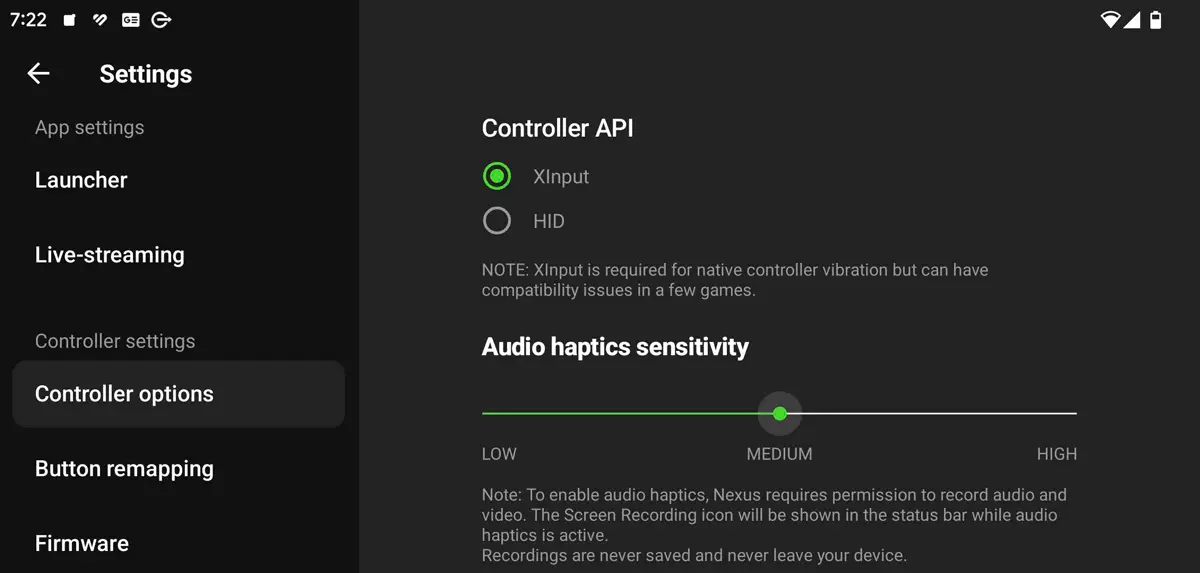
The one feature that wasn’t covered in the review is that of HyperSense Haptics support. The reason for that omission is that, at the time, the V2 Pro hadn’t been released. Now that it has, we were able to put that feature to the test. There are a few caveats though. First, the haptics are audio-based so they don’t always match up with the gameplay as one would expect. That being said, there was just enough vibration to make mobile gaming just that much more immersive. Second, the haptics only work in Android and to enable it for Game Pass games, you need to jump through a few hoops. To enable haptics, you need to undertake the following steps:
- Uninstall the Xbox Game Pass app (if you have it installed). Game Pass Games run through Chrome via the Nexus 3.0 application.
- Open Nexus 3.0 Settings > Launcher > Enable Xbox Cloud Gaming
- Go back to the dashboard, scroll down to the Xbox section and select a game
- A pop-up will show, with a link, a button to copy the link, and a button to open Chrome
- Copy the link (chrome://flags/#enable-android-gamepad-vibration) then open chrome
- Paste the link into the URL bar
- You *should* see an experiment titled “Gamepad vibration” – if you do, change “Default” to “Enabled” then close Chrome and relaunch Razer Nexus. Proceed to step 14
- If you don’t see “Gamepad vibration” on the screen, type chrome://flags/#temporary-unexpire-flags-m115
- Find “Temporarily unexpire M115 flags” and change to “Enabled”
- If present, change “Temporarily unexpire M116 flags” to “Enabled”
- Press “Relaunch” to reload Chrome
- Either paste chrome://flags/#enable-android-gamepad-vibration into the URL bar or type “gamepad” into the search box
- Change “Gamepad vibration” from “Default” to “Enabled” then close Chrome and relaunch the Razer Nexus app
- Navigate to the Xbox Game Pass game of your choice and tap it
- Chrome will launch the Xbox Cloud Gaming (Beta) page
- Log in, launch the game, and haptics should be enabled
While it is a few steps to take, hopefully, in the near future, gamepad vibration will be easier to toggle and access.
Oh, and if you don’t have it, the controller comes with a 1-month Xbox Game Pass Ultimate subscription which can be redeemed through the Razer website.
Performance
As mentioned above, the Razer Kishi V2 Pro is comfortable to hold and the textured grips nestled nicely in the palm of my hands. I’m a huge fan of mechanical keyboards and the microswitch buttons on the Razer Kishi V2 Pro remind me of going from a standard membrane to a mechanical keyboard. In fact, I now find my regular Xbox controllers a bit spongy when using (although they still work fine) after using the microswitch buttons on the Kishi V2 Pro.
Like the Kishi V2, the triggers and buttons are very responsive. If anything the triggers might be a tad sensitive and require very light pulls to respond. It would be nice if you could adjust the sensitivity, again, maybe this is something that can be done in a future firmware/software update. With its USB-C connection, you don’t have to worry about Bluetooth or wireless latency as there is practically none with the Kishi V2 Pro.
While testing, I ran quite a few games with the controller including the recently released Diablo Immortal. Asphalt 9 responded as I would expect and the number of Game Pass games I tried were much more enjoyable to play with a mobile controller than with touch controls. Whether it was games like Forza Horizon 5, Assassin’s Creed Origins, Sniper Elite 5, or Pac-Man Museum, I found the controls to be better than most mobile controllers I’ve tried in the past.
Where the Kishi V2 Pro really shines though, is the HyperSense Haptics. With three levels (low, medium, high), you can set it to your liking. As mentioned above, it is audio-based so you need your audio on (although it seemed to work fine with my Pixel 7 muted). Depending on the game you play, the haptics may be a bit hit and miss as the odd time it seemed to “follow” the game music as opposed to the rumble of an engine or firing of a gun like console vibrations do. Personally, I liked the medium setting which offered up a nice balance, especially for games like Forza Horizon 5 and Diablo Immortal.
As for the share button, tapping it will take a screenshot and store it in a Nexus folder on your device.
Overall, the Razer Kishi V2 Pro performs well. The only thing that could make it better is if, as mentioned, you could adjust the trigger and thumbstick sensitivity, as well as remap more than just the M1/M2 buttons. Another addition that would only improve the Kishi mobile game controller is if swappable thumbsticks of different heights or different thumbpads were available.
Price/Value
As tested, our Razer Kishi V2 Pro Xbox edition retails for $149.99. While the dedicated Xbox button is nice, unless you’re a new Game Pass Ultimate subscriber and can redeem the free month, you’re definitely paying a brand tie-in tax here. Fortunately, the Razer Kishi V2 Pro also comes in a black, non-Xbox version which retails for $129.99. Given the non-pro version sells for $99.99, $30 is a small price to pay for a more immersive gaming experience with the addition of HyperSense Haptics. On that note, if you don’t care about haptic feedback while gaming on your mobile device, you still can’t go wrong with the Razer Kishi V2.
Photo Gallery
Wrap-up
While only a minor upgrade from the Razer Kishi V2 mobile controller for Android, the addition of haptic feedback and a 3.5mm audio jack make a huge difference when it comes to mobile gaming. It is a bit pricier, but well worth it, especially if you’re into Xbox Cloud Gaming.
Razer Kishi V2 Pro
$129.99+Nailed it
- Comfortable, solid, stable design
- Microswitch buttons, triggers, and D-Pad are responsive
- USB-C connection for virtually no latency
- HyperSense Haptics add another level of immersion
- Addition of 3.5mm audio jack for lag free audio
- Remappable M1/M2 buttons
- USB-C passthrough charging
- Dedicated share and Xbox buttons
- Xbox version includes 1 month Game Pass Ultimate for new subscribers
- Available in white or black
Needs work
- Takes some configuration to get haptics working in Game Pass games
- For haptics support, have to stream Game Pass games through Chrome
- Haptics are audio based so not as accurate as console based haptics
- Only M1/M2 buttons are remappable
- Would be nice to be able to adjust trigger and thumbstick sensitivity
- Xbox version pricier
In some of our articles and especially in our reviews, you will find Amazon or other affiliate links. As Amazon Associates, we earn from qualifying purchases. Any other purchases you make through these links often result in a small amount being earned for the site and/or our writers. Techaeris often covers brand press releases. Doing this does not constitute an endorsement of any product or service by Techaeris. We provide the press release information for our audience to be informed and make their own decision on a purchase or not. Only our reviews are an endorsement or lack thereof. For more information, you can read our full disclaimer.
Last Updated on March 13, 2024.

